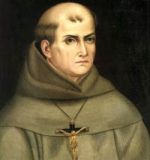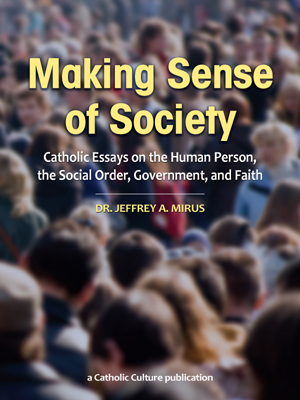Matching Books to Readers, I: Monti’s A Sense of the Sacred
By Dr. Jeff Mirus ( bio - articles - email ) | Mar 21, 2013 | In Reviews
Occasionally a truly fine book will come across my desk which deserves to be more widely known, meriting close and enthusiastic reading by a particular Catholic audience, but which simply does not cover a subject in which I have the requisite personal interest. Two perfect examples have arrived in the last month. The first is James Monti’s incomparable study of Catholic worship in the Middle Ages, entitled A Sense of the Sacred, published by Ignatius Press.
Our modern sense of liturgy and the sacraments is gravely attenuated. In the 21st century, Catholics tend to inhabit a horizontal world in which they are taught how not to contemplate reality and how not to let anything remind them of the saving mysteries of God. The medieval world was a rich contrast to our own, with a keen emphasis on the vertical, and a vibrant liturgical imagination which incorporated centuries of accumulated reflections on the interconnections between this world and the next.
It is James Monti’s thesis—and in this he is surely correct—that a primary way of rediscovering and enriching our own sacramental and liturgical experience is to study the manner in which the sacraments were celebrated in the Middle Ages, learning how the medieval church transformed human events by emphasizing their cosmic connections with the saving power of Christ. Monti is well-qualified to lead us in this task. Not only has he done an exhaustive study of Medieval prayers, hymns, and rubrics but he is skilled at deepening the liturgical perceptions of contemporary Catholics, as exemplified by his writings in the immensely popular and well-executed monthly Magnificat series.
A Sense of the Sacred is divided into three parts, covering the Sacraments, the Liturgical Year (what we might call sacred time, with an emphasis on such feasts as Christmas and Easter), and other rites of the Church—including the canonization of saints and, of special interest at this moment, the election, installation and coronation of a pope. Each chapter provides a survey and explanation of the rich reverence the Medieval Church brought to its celebration of these sacred rites—rites which not only recall but implement the salvific power of our Redeemer.
This is a comprehensive study of some 700 pages, and when I admit I have not read it all, I am simply confessing a deficiency in myself. What I have done is sampled it sufficiently to assess its value. Every reader must ultimately pass over fine works which he lacks either time or inclination to pursue. At the same time, all of us must be interested in increasing the sense of the sacred and the awareness of the mysteries of grace in our world. Therefore, those who are particularly drawn to ritual and liturgy as a key component of this recovery will not only enjoy Monti’s excellent text but benefit immensely from it.
The author himself captures the promise of his book in the introduction:
While there are many features of medieval and Baroque liturgy [the Baroque is to be the subject of a subsequent book] to command our attention, it is the profound sense of the sacred permeating these rites that so urgently needs to be renewed in our own time. One of the major misinterpretations of the liturgical renewal of the Second Vatican Council has been the idea that Catholic worship somehow needs to be desacralized, secularized, and politicized in order to make it relevant to contemporary society. Hence it will be a major objective of the present work to convince the reader that the sense of the sacred is essential to the liturgy, a dimension inherited from the liturgy of the Old Testament and rooted in the teachings of the Church Fathers.
James Monti delivers admirably on this promise.
See also Matching Books to Readers, II: Stroik’s The Church Building as a Sacred Place.
All comments are moderated. To lighten our editing burden, only current donors are allowed to Sound Off. If you are a current donor, log in to see the comment form; otherwise please support our work, and Sound Off!
-
Posted by: Retired01 -
Apr. 22, 2018 3:55 PM ET USA
Father Hunwicke wants some questions answered. Hopefully, he will not have to wait longer than those who want Pope Francis to answer the dubia.
-
Posted by: james-w-anderson8230 -
Apr. 21, 2018 10:41 PM ET USA
Pope Francis has said that there is zero tolerance for covering up sexual abuse of children. What penalty is he going to apply to himself? He restored to active ministry a priest who had been arrested for that crime. The priest was subsequently arrested again. Is the law only for others and not for bishops?
-
Posted by: claude-ccc2991 -
Apr. 21, 2018 9:37 PM ET USA
The first act guided by "Cupich conscience" was Eve's bite of the apple. The problem with acts of "Cupich conscience" is that they ultimately bite back.
-
Posted by: shrink -
Apr. 21, 2018 6:48 AM ET USA
The persons involved the Chile disaster were participants in a criminal conspiracy, either by commission or omission, because, as clergy, they had a duty to protect, and they failed. This failure includes our current pontiff, who has admitted negligent due diligence. The laity and the innocent clergy have a right to know what happened, and a right to know what (if any) punishments of whom have been effected. A failure to do so is yet another attack upon the Common Good of the Church.
-
Posted by: feedback -
Apr. 20, 2018 7:25 PM ET USA
Thank you especially for the top link to the Echeverria article. Detroit's Sacred Heart Seminary is truly blessed with great teachers.








